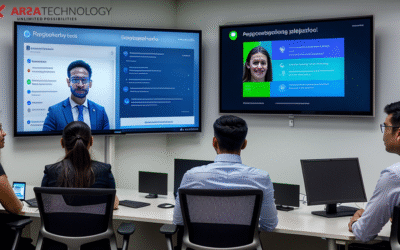Introduction: Overcoming Manual Broadcast Automation Workflows in the Media Industry
In the fast-paced world of media, efficiency and scalability are paramount. Yet, many organizations still grapple with manual broadcast automation workflows, leading to bottlenecks, increased operational costs, and slower content delivery. This challenge is particularly acute in areas like IVR (Interactive Voice Response) systems and voice assistant development, where the demand for dynamic, natural-sounding voice content is constantly growing. The reliance on human voice talent for every update, announcement, or interactive prompt is not only time-consuming but also limits the ability to rapidly adapt to changing content needs or expand into new languages.
ARSA Technology understands these pain points. We recognize that media companies need a robust, scalable, and intelligent solution to automate voice content creation without compromising on quality. This guide explores how migrating to ARSA’s advanced Text-to-Speech (TTS) API can revolutionize your media operations, transforming manual processes into seamless, automated workflows that deliver superior auditory experiences. We’ll delve into the strategic advantages, key features, and a high-level migration pathway to help you make an informed decision and unlock new efficiencies.
The Cost of Manual Voice Production: Why Media Companies Need a Change
The traditional approach to voice content generation in media, especially for IVR and voice assistants, is fraught with inefficiencies. Recording new voiceovers for every piece of news, advertisement, or interactive prompt demands significant resources – from hiring voice artists and booking studio time to managing complex editing and integration processes. This manual overhead directly impacts your bottom line and agility.
Consider the implications for:
* Dynamic News Updates: Delivering real-time news across various platforms requires immediate voice synthesis, which manual methods cannot provide.
* Personalized Advertising: Crafting unique audio ads tailored to individual listener preferences is impossible at scale without automation.
* Multilingual Content: Expanding into new markets means replicating the entire voice production process for each language, a costly and time-consuming endeavor.
* IVR System Agility: Updating IVR menus or responses quickly to reflect new promotions or service changes is critical for customer experience but cumbersome with manual recordings.
These challenges highlight a clear need for a technological shift. Media companies are looking for solutions that reduce operational friction, accelerate content deployment, and maintain a high standard of voice quality. ARSA Technology’s Text-to-Speech API is engineered precisely to address these demands, offering a pathway to automation that is both powerful and practical.
Introducing ARSA Technology’s Text-to-Speech API: A Paradigm Shift for Media
ARSA Technology’s Text-to-Speech API is a cutting-edge voice synthesis solution designed to convert written text into natural-sounding speech with remarkable accuracy and expressiveness. Unlike older, robotic-sounding TTS systems, our API leverages advanced AI and deep learning models to generate voices that are virtually indistinguishable from human speech. This capability is a game-changer for media organizations aiming to enhance listener engagement and streamline their content creation pipelines.
Our API offers a rich array of features tailored to the demanding requirements of the media industry:
* Natural and Expressive Voices: Choose from a diverse selection of high-quality voices that convey appropriate emotion and intonation, ensuring your content resonates with your audience.
* Multilingual Support: Seamlessly generate voice content in multiple languages, enabling you to reach global audiences without the need for additional voice talent or localization efforts.
* Customizable Speech Parameters: Fine-tune speech rate, pitch, and volume to match your brand’s voice guidelines or specific content requirements.
* Scalability and Reliability: Built for enterprise-grade performance, our API can handle high volumes of text-to-speech conversions, ensuring your broadcast automation workflows never miss a beat.
To see the API in action and experience the quality of our voice synthesis firsthand, try the Text-to-Speech API on RapidAPI. This interactive demo allows you to input text and hear the generated speech, providing immediate insight into its capabilities.
Strategic Advantages of Migrating to ARSA’s Text-to-Speech API
Migrating to ARSA’s Text-to-Speech API is not just a technical upgrade; it’s a strategic investment that yields significant business advantages for media companies:
1. Unlocking Unprecedented Efficiency and Speed:
Automate the conversion of scripts, news articles, ad copy, and IVR prompts into spoken audio in real-time. This eliminates the delays associated with manual recording, allowing for rapid content deployment and immediate updates. Imagine pushing out breaking news alerts or dynamic ad campaigns within minutes, not hours or days.
2. Significant Cost Reduction:
Reduce reliance on expensive voice talent, studio time, and post-production editing. The API offers a cost-effective alternative for generating high-quality voice content at scale, freeing up budget for other critical areas of your operation. This is particularly impactful for companies producing a high volume of diverse content.
3. Enhanced Content Personalization and Dynamic Delivery:
Leverage the API to create highly personalized audio experiences. For IVR systems, this means dynamic responses based on user input or account status. For broadcast, it enables tailored ad reads or news segments that adapt to listener demographics or preferences, driving deeper engagement.
4. Global Reach with Multilingual Capabilities:
Expand your audience effortlessly by generating content in various languages. Our API’s multilingual support allows you to localize your voice content quickly and efficiently, opening new markets and strengthening your international presence without the logistical complexities of managing multiple voice actors.
5. Consistent Brand Voice and Quality:
Maintain a consistent brand voice across all your audio touchpoints. With customizable voice parameters, you can ensure that every piece of synthesized speech aligns with your brand’s auditory identity, fostering a professional and cohesive listening experience for your audience.
6. Future-Proofing Your Media Operations:
Integrating an AI-powered TTS solution positions your company at the forefront of media innovation. It prepares you for the increasing demand for voice-enabled applications, smart speakers, and advanced IVR systems, ensuring you remain competitive in a rapidly evolving digital landscape.
A High-Level Migration Pathway: Switching to ARSA’s Text-to-Speech API
Migrating to a new API can seem daunting, but with ARSA Technology, the process is designed to be straightforward and supported. Here’s a high-level overview of what a migration might entail:
1. Assessment and Planning:
Begin by evaluating your current voice content generation workflows. Identify key areas where manual processes create bottlenecks and where ARSA’s Text-to-Speech API can deliver the most significant impact, particularly for IVR and voice assistant development. Define your specific requirements for voice quality, language support, and integration points within your existing systems. This phase is crucial for setting clear objectives and understanding the scope of the migration.
2. Integration Strategy:
Our API is built for ease of integration. Your development team will focus on replacing your existing voice synthesis or recording mechanisms with calls to ARSA’s Text-to-Speech API. This typically involves identifying where text is currently converted to speech or where human voiceovers are inserted, and then programming your applications to send that text to our API instead. The API handles the complex task of converting text into high-fidelity audio, which your application then receives and uses.
3. Voice Selection and Customization:
Explore the range of voices available through ARSA Technology. Select voices that best align with your brand identity and the specific context of your content (e.g., a formal voice for news, a friendly voice for a voice assistant). Experiment with speech parameters like pitch and rate to achieve the desired auditory experience. Remember, you can try the Text-to-Speech API on RapidAPI to test different voice options and settings interactively.
4. Testing and Optimization:
Thoroughly test the integrated solution within your existing broadcast automation, IVR, or voice assistant platforms. Evaluate the quality of the synthesized speech, the responsiveness of the system, and its performance under various loads. Gather feedback from internal stakeholders and make any necessary adjustments to voice parameters or integration logic to optimize the user experience.
5. Deployment and Monitoring:
Once testing is complete and satisfactory, deploy the new Text-to-Speech API integration into your production environment. Continuously monitor its performance and listen for opportunities to further refine your voice content strategy. ARSA Technology is committed to providing reliable service, ensuring your automated workflows run smoothly.
For more information on how our AI APIs can transform your operations, explore our full suite of AI APIs. Each product is designed with enterprise needs in mind, offering robust solutions for various challenges.
Conclusion: Your Next Step Towards a Solution
The media industry is at an inflection point, where automation and AI are no longer optional but essential for competitive advantage. Manual broadcast automation workflows are a relic of the past, hindering innovation and draining resources. By migrating to ARSA Technology’s Text-to-Speech API, you are not just adopting a new technology; you are embracing a future of unparalleled efficiency, scalability, and enhanced listener engagement for your IVR and voice assistant development.
This strategic move will empower your organization to deliver dynamic, high-quality voice content faster and more cost-effectively than ever before, positioning you as a leader in the evolving digital media landscape. Ready to transform your operations and elevate your auditory experiences? Don’t hesitate to contact our developer support team. We are here to assist you every step of the way, from initial inquiry to seamless integration, ensuring your migration is a resounding success.
Ready to Solve Your Challenges with AI?
Discover how ARSA Technology can help you overcome your toughest business challenges. Get in touch with our team for a personalized demo and a free API trial.







